The chemical industry encircles a broad economic sector. It includes the production of “commodity chemicals”, from pharmaceutical products to polymers, food, petrochemicals and intermediates, dyes, and so on.
Given that water is used in most of the chemical processes, along with the diversity of products that derive from this subsector, it is not a surprise that the chemical industry is one of the largest water consumers. On the other hand, this subsector is also the core of novel technologies and advanced solutions when it comes to a sustainable use of natural resources.
In the processing industry, water is used for heating or cooling products and equipment, for vacuum creation, steam production, preparation of solvents and reaction media, extractive or absorptive reagents, product rinsing, and distillation, transport of products, washing, among other processes.
The requirement for high temperatures and pressures pushes the need for feeding industrial equipment with high-purity water, so related operational challenges, like equipment fouling are minimized. In this case, water demineralization and treatment become relevant as a way to ensure correct equipment operation and stable processes.
Within the chemical industry, the most water-intensive and demanding operation is cooling. Water’s physical and chemical properties allow it to be the first alternative for heat exchange operations in chemical processing. Moreover, water is the cheapest and most widely available heat exchange medium, despite the existence of other heat exchanging fluids, like ethylene glycol.
Many chemical reactions generate or require heat which must be removed from or added to the reaction vessel. This keeps the process going at a steady and safe pace as shown in Figure 1.
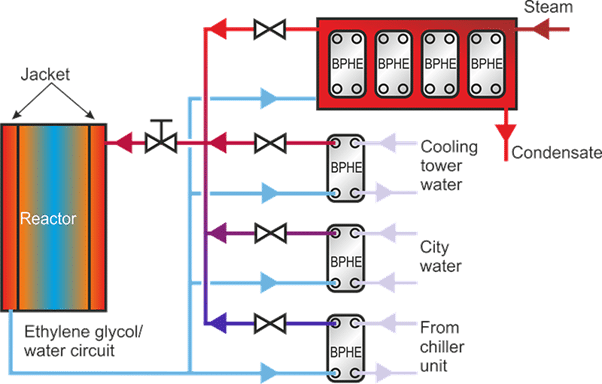
Source: https://www.swep.net/industrial-handbook/temperature-control-systems/
Water is then transported to cooling towers as those shown in Figure 2, where it exchanges heat with the environment by mass and heat transfer.

Mass transfer between hot water and the environment implies that part of the water will be lost, meaning that freshwater input is necessary at this instance to compensate for losses. A brief graphic explanation of the cooling process within the towers is shown in Figure 3.
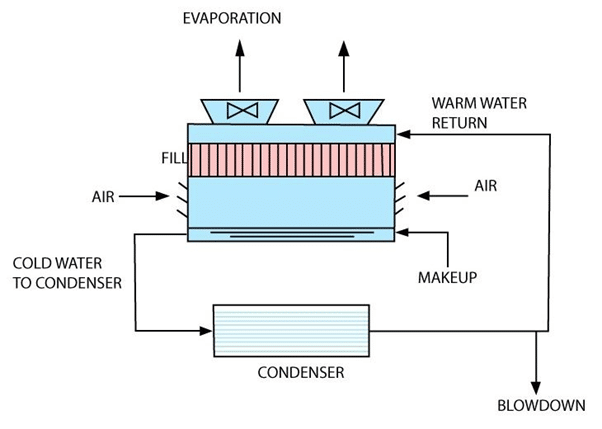
Water demand is expected to increase by 400% by 2050 for the manufacturing industry[1]. Approximately 19% of the global water withdrawals are used for industrial purposes, out of which 17% is accounted to high-income countries, whereas the remaining 2% belong to low-income countries[2] as shown in Figure 4.
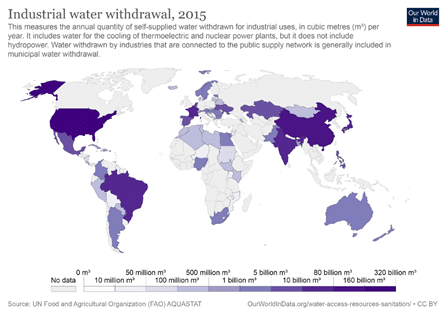
The European chemical and refinement industry is responsible for 50% of all water use in the manufacturing industry, and it represents 6% of the total freshwater extracted[3]. Figure 5 reveals the Netherlands, Belgium, and Norway as the countries with the largest water input to the chemical industry.
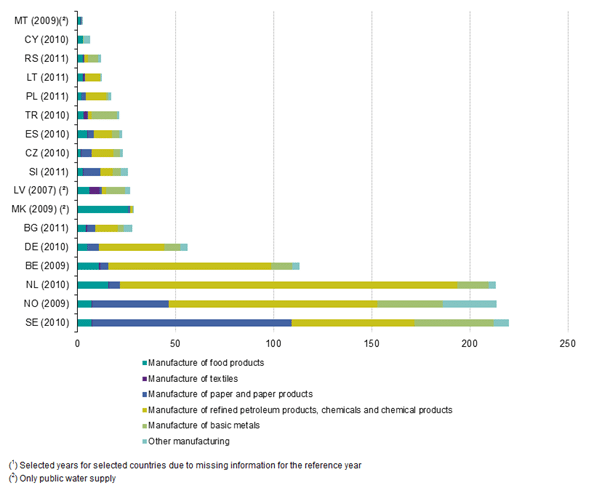
Being such a water-intensive activity, the chemical industry faces the challenge of water scarcity added to the emission of pollutants to water bodies. The industry is responding to this circumstance by using less freshwater and reducing emissions waste into rivers. Water quality and quantity is no longer a matter of cost, but efficient management and use. Much of the most sustainable efficiency measures of a plant’s operation are based on recycling and reusing water[5].
Yet with the increasing water scarcity coming ahead, the chemical industry must move beyond pure internal water recycling and reuse, like shown in Figure 6. The sector is being challenged to keep operating and expanding as water stress becomes a critical problem in some areas, pushing it to enhance its processes while moving towards optimal management of water sources.
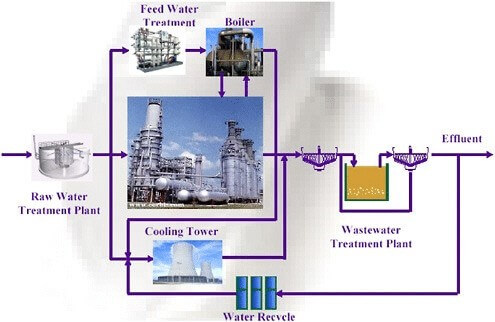
Further, than the mere implementation of wastewater treatment and recycling within the industrial environment, sustainable use of water in the industrial sector passes by creating large-scale water collectors, tapping new groundwater sources, or in some cases, desalinating seawater[7].
Yet, under increasing water stress situations, the chemical industry must walk beyond an individualistic perspective and adopt a holistic approach, where symbiotic interaction with other sectors, or industries of the same nature, is used as a pillar for sustainable water management.
This symbiosis includes interconnecting the industry with the urban and rural environment, to drive forward a comprehensive and sustainable water management strategy, that allows reusing treated water from different processing lines, industries, or sectors[3] within the chemical processing line, like shown in Figure 6.
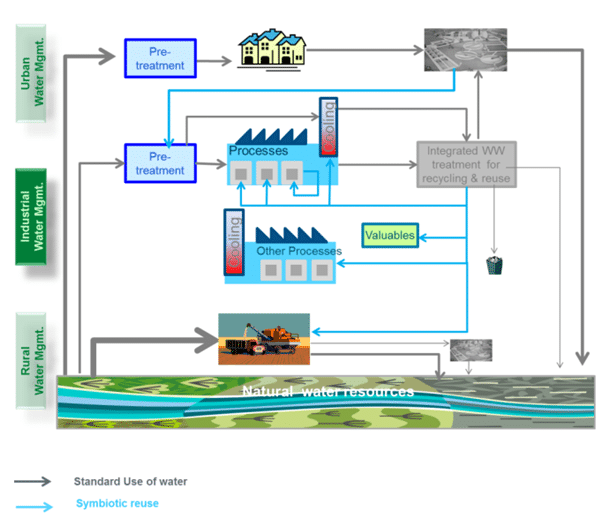
Moreover, this strategy includes the incorporation of advanced technologies, so the requirements of one sector or the other are met without compromising the distinct water quality necessities. For this aim, technologies such as reverse osmosis (RO), microfiltration (MF), and ultrafiltration (UF) membranes are a good choice for coupling industrial and domestic water streams[6].
When coupling a membrane bioreactor that treats domestic wastewater, with a clarification membrane, a very high-quality water stream is generated, and this can be injected into the processing line without major concerns for the process downstream[6].
Our BOSAQ water experts are keen to assist the manufacturing industry in finding the best way to reduce the water footprint of your process without compromising the final quality of your products. Our water treatment technology based on high-quality membranes can help you to integrate wastewater streams from other processes to cover your needs without compromising freshwater resources.
[1]A. Boretti and L. Rosa, ‘Reassessing the projections of the World Water Development Report’, Npj Clean Water, vol. 2, no. 1, Art. no. 1, Jul. 2019, doi: 10.1038/s41545-019-0039-9.
[2]H. Ritchie and M. Roser, ‘Water Use and Stress’, Our World Data, Nov. 2017, Accessed: Sep. 30, 2020. [Online]. Available: https://ourworldindata.org/water-use-stress.
[3]‘ChemWater - Chemistry-Water synergies’. https://chemwater.eu/index.php/Chemistry-Water-synergies/Chemistry-Water-synergies.html (accessed Oct. 01, 2020).
[4]‘Archive:Water use in industry - Statistics Explained’. https://ec.europa.eu/eurostat/statistics-explained/index.php/Archive:Water_use_in_industry#Water_use_in_manufacturing_industry (accessed Oct. 01, 2020).
[5]S. Milmo, ‘Thisrty work’, Chemistry World, Sep. 2008.
[6]Water and Sustainable Development: Opportunities for the Chemical Sciences: A Workshop Report to the Chemical Sciences Roundtable. .
[7]‘How Manufacturing Facilities in the Chemical Industry Can Reduce Water’, Samco Tech, Aug. 06, 2020. https://www.samcotech.com/how-manufacturing-facilities-chemical-industry-can-reduce-water-usage/ (accessed Oct. 02, 2020).